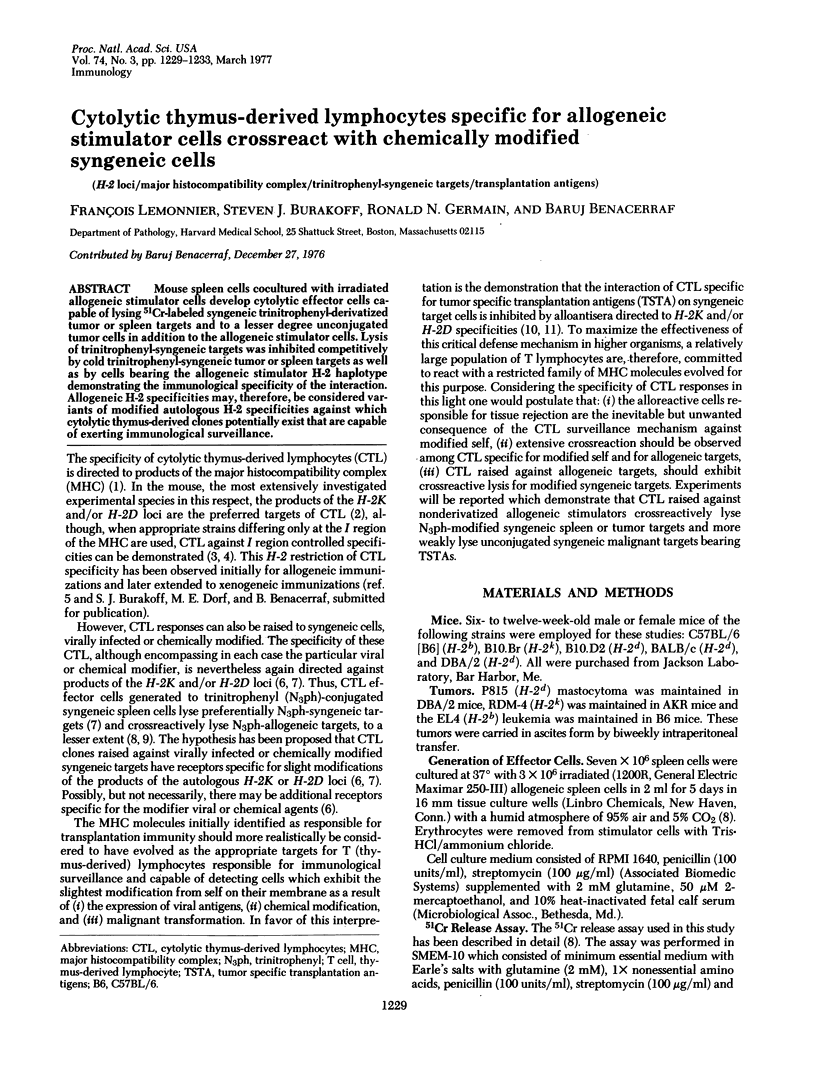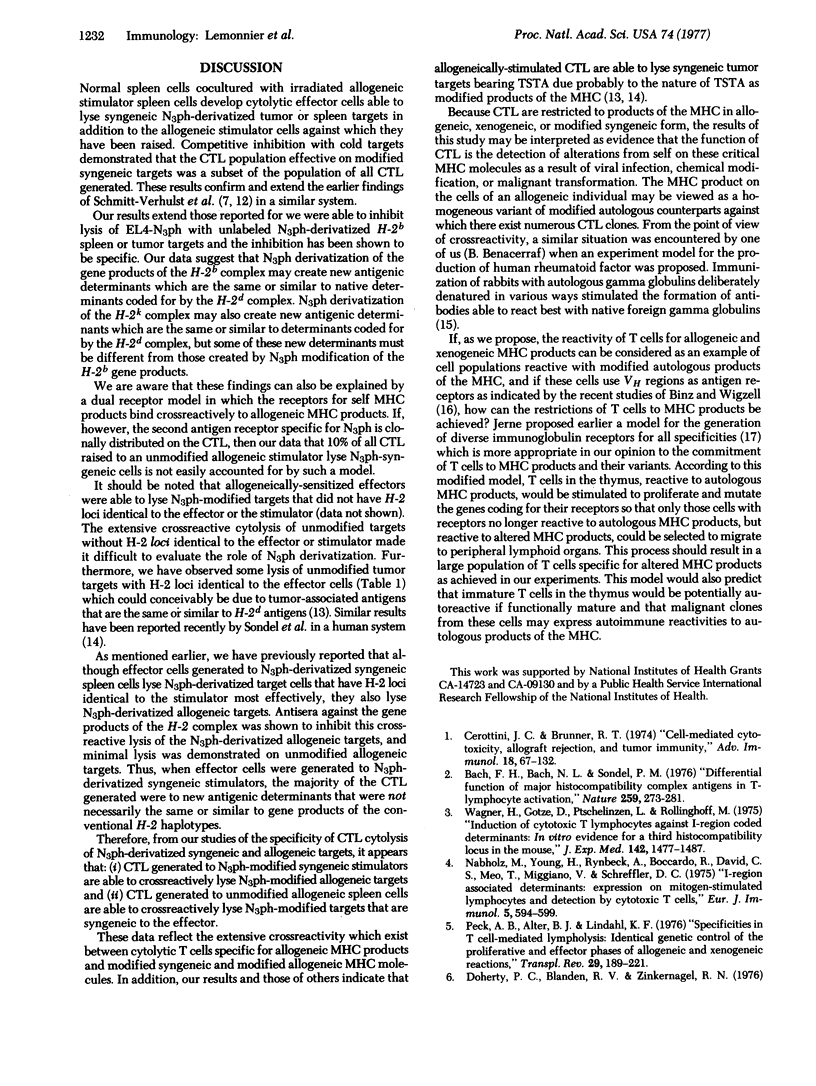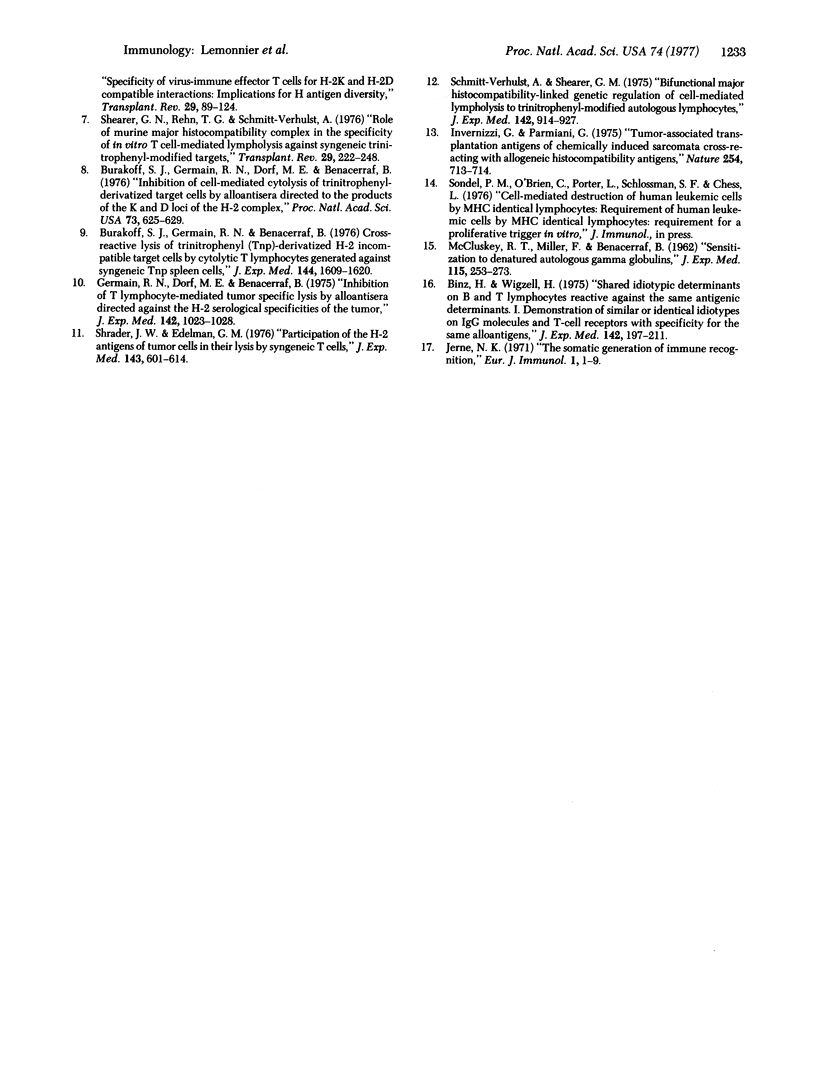Abstract
Mouse spleen cells cocultured with irradiated allogeneic stimulator cells develop cytolytic effector cells capable of lysing 51Cr-labeled syngeneic trinitrophenyl-derivatized tumor or spleen targets and to a lesser degree unconjugated tumor cells in addition to the allogeneic stimulator cells. Lysis of trinitrophenyl-syngeneic targets was inhibited competitively by cold trinitrophenyl-syngeneic tumor or spleen targets as well as by cells bearing the allogeneic stimulator H-2 haplotype demonstrating the immunological specificity of the interaction. Allogeneic H-2 specificities may, therefore, be considered variants of modified autologous H-2 specificities against which cytolytic thymus-derived clones potentially exist that are capable of exerting immunological surveillance.
Full text
PDF




Images in this article
Selected References
These references are in PubMed. This may not be the complete list of references from this article.
- Bach F. H., Bach M. L., Sondel P. M. Differential function of major histocompatibility complex antigens in T-lymphocyte activation. Nature. 1976 Jan 29;259(5541):273–281. doi: 10.1038/259273a0. [DOI] [PubMed] [Google Scholar]
- Binz H., Wigzell H. Shared idiotypic determinants on B and T lymphocytes reactive against the same antigenic determinants. I. Demonstration of similar or identical idiotypes on IgG molecules and T-cell receptors with specificity for the same alloantigens. J Exp Med. 1975 Jul 1;142(1):197–211. doi: 10.1084/jem.142.1.197. [DOI] [PMC free article] [PubMed] [Google Scholar]
- Burakoff S. J., Germain R. N., Benacerraf B. Cross-reactive lysis of trinitrophenyl (TNP)-derivatized H-2 incompatible target cells by cytolytic T lymphocytes generated against syngeneic TNP spleen cells. J Exp Med. 1976 Dec 1;144(6):1609–1620. doi: 10.1084/jem.144.6.1609. [DOI] [PMC free article] [PubMed] [Google Scholar]
- Burakoff S. J., Germain R. N., Dorf M. E., Benacerrah B. Inhibition of cell-mediated cytolysis of trinitrophenyl-derivatized target cells by alloantisera directed to the products of the K and D loci of the H-2 complex. Proc Natl Acad Sci U S A. 1976 Feb;73(2):625–629. doi: 10.1073/pnas.73.2.625. [DOI] [PMC free article] [PubMed] [Google Scholar]
- Cerottini J. C., Brunner K. T. Cell-mediated cytotoxicity, allograft rejection, and tumor immunity. Adv Immunol. 1974;18:67–132. doi: 10.1016/s0065-2776(08)60308-9. [DOI] [PubMed] [Google Scholar]
- Germain R. N., Dorf M. E., Benacerraf B. Inhibition of T-lymphocyte-mediated tumor-specific lysis by alloantisera directed against the H-2 serological specificities of the tumor. J Exp Med. 1975 Oct 1;142(4):1023–1028. doi: 10.1084/jem.142.4.1023. [DOI] [PMC free article] [PubMed] [Google Scholar]
- Invernizzi G., Parmiani G. Tumour-associated transplantation antigens of chemically induced sarcomata cross reacting with allogeneic histocompatibility antigens. Nature. 1975 Apr 24;254(5502):713–714. doi: 10.1038/254713a0. [DOI] [PubMed] [Google Scholar]
- Jerne N. K. The somatic generation of immune recognition. Eur J Immunol. 1971 Jan;1(1):1–9. doi: 10.1002/eji.1830010102. [DOI] [PubMed] [Google Scholar]
- Nabholz M., Young H., Rynbeek A., Boccardo R., David C. S., Meo T., Miggiano V., Shreffler D. C. I-region-associated determinants: expression on mitogen-stimulated lymphocytes and detection by cytotoxic T cells. Eur J Immunol. 1975 Sep;5(9):594–599. doi: 10.1002/eji.1830050903. [DOI] [PubMed] [Google Scholar]
- Peck A. B., Alter B. J., Lindahl K. F. Specificity in T cell mediated lympholysis: identical genetic control of the proliferative and effector phases of allogeneic and xenogeneic reactions. Transplant Rev. 1976;29:189–221. doi: 10.1111/j.1600-065x.1976.tb00202.x. [DOI] [PubMed] [Google Scholar]
- Schmitt-Verhulst A. M., Shearer G. M. Bifunctional major histocompatibility-linked genetic regulation of cell-mediated lympholysis to trinitrophenyl-modified autologous lymphocytes. J Exp Med. 1975 Oct 1;142(4):914–927. doi: 10.1084/jem.142.4.914. [DOI] [PMC free article] [PubMed] [Google Scholar]
- Schrader J. W., Edelman G. M. Participation of the H-2 antigens of tumor cells in their lysis by syngeneic T cells. J Exp Med. 1976 Mar 1;143(3):601–614. doi: 10.1084/jem.143.3.601. [DOI] [PMC free article] [PubMed] [Google Scholar]
- Shearer G. M., Rehn T. G., Schmitt-Verhulst A. M. Role of the murine major histocompatibility complex in the specificity of in vitro T-cell-mediated lympholysis against chemically-modified autologous lymphocytes. Transplant Rev. 1976;29:222–246. doi: 10.1111/j.1600-065x.1976.tb00203.x. [DOI] [PubMed] [Google Scholar]
- Wagner H., Götze D., Ptschelinzew L., Röllinghoff M. Induction of cytotoxic T lymphocytes against I-region-coded determinants: in vitro evidence for a third histocompatibility locus in the mouse. J Exp Med. 1975 Dec 1;142(6):1477–1487. doi: 10.1084/jem.142.6.1477. [DOI] [PMC free article] [PubMed] [Google Scholar]




